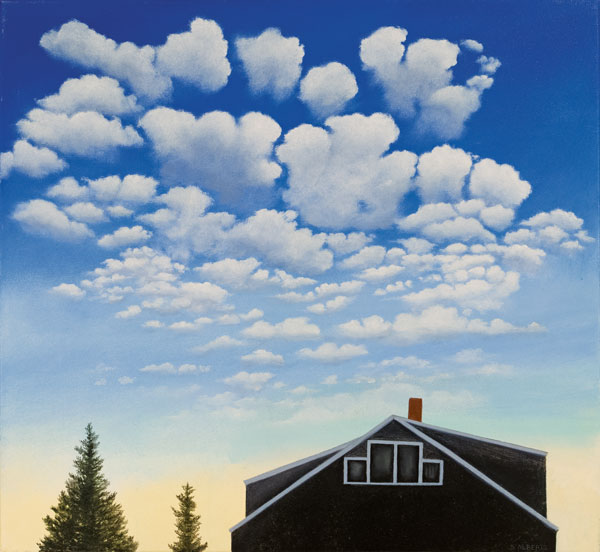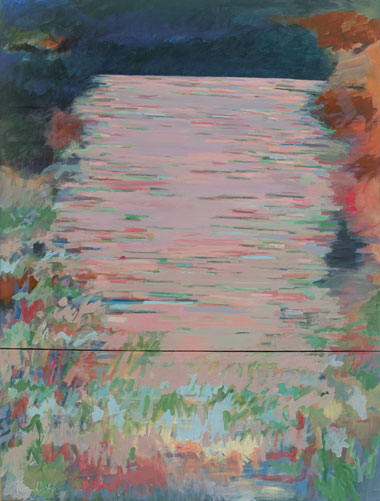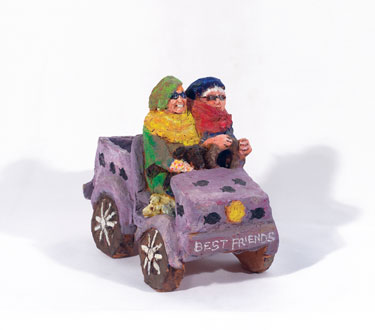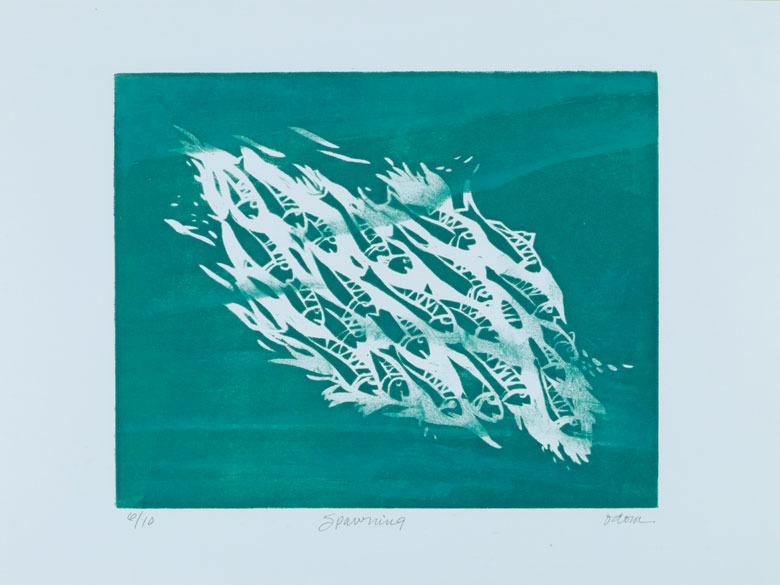
As curator Emily Grey relates in the catalogue for “Woman Artists of Monhegan Island: A Common Bond” on view at the Monhegan Museum of Art and History, Elena Jahn (1938-2014) and Frances Kornbluth (1920-2014) founded this collective in 1990 “as a way for women artists on the island, with greater intention than in previous generations, to create a space for collaboration and ‘mutual support’ in a newly invigorated Monhegan art community.”
Grey goes on to explain that membership in the collective was limited to 15 artists “based on exhibition and storage limitations” and that the artists were required to be actively showing in galleries and to spend at least six weeks on Monhegan each year.
“In a spirit of egalitarianism, common in many contemporary women’s cooperatives and groups,” she notes, the members “used identical frames of the same size.”
Over the years, Women Artists of Monhegan Island, or WAMI, held exhibitions in a variety of venues, on and off Monhegan.
The “pinnacle” of these shows, notes Grey, was “On Island: Women Artists of Monhegan” at the University of New England Gallery in 2007. Co-curated by WAMI member Kate Chappell and gallery director Anne Zill, the exhibition, wrote the latter, was an opportunity “to right a wrong” and “demonstrate that women’s artistic talents are just as good as their male counterparts.”
“Woman Artists of Monhegan Island: A Common Bond” offers another excellent demonstration of this collective’s praiseworthiness. With a couple of exceptions, all 18 artists in the show are represented by three works. The images range from realist to abstract, with many variations in between.
Inspired by their mentor and fellow Monhegan painter Reuben Tam (1916-1991), Kornbluth and Jahn brought expressionist energy to their island paintings. Kornbluth’s “Changing Light, Monhegan Ice Pond,” (1989) evokes a shimmering cascade of what might be moonlight on the water framed by colorful foliage.
Jahn’s “Red Rocks, Monhegan,” (1959) is bold and fiery.
A view of the Eider Duck cottage on Fish Beach beneath an array of clouds by Sylvia Alberts (1928-2015) has a Magritte-like feel—real yet surreal. By contrast, Natalie Minewski (1927-2017) responded to the landscape by way of a dynamic collage that mixes night and day and island elements.
Yolanda Fusco (1920-2009), Beth Van Houten (1945–2022), and Evelyn Davis (1905–2000) bring impressionist/expressionist energy to their arrangements of fruit and flowers. An untitled watercolor still life by Susan Rosenthal (1905–1997) features a simple bouquet in a tall pitcher—a lovely evocation of summer.

In translucent watercolors Ruth Boynton (1915-2003), Joanne Scott (1928-2021), and Joan Rappaport (1941-2019) found poetry in beach stones, pebbles, rocks, shells, and seaweed. Also notable is “Tangled Nets II,” a wild and colorful mixed-media piece by Nancy Thompson Brown (1926–2019), and the Thiebaud-esque “Men Cigarettes” by Arline Simon (1927–2020).
Various print techniques come into play. Frankie Odom (1941–2019) turned to ink print embossment to create “Spawning,” a flurry of fish that brought to mind Morris Graves’s “Flight of Plover.” A lithograph by Jacqueline Hudson (1910–2001), “Maine Morning,” captures the calm of a new island day.
The sole sculptor in the show, Lucia Taylor Miller (1928–2019), delighted in the figure in her work. Her charming painted terra cotta “Best Friends” shows WAMI cofounders Jahn and Kornbluth, all smiles in sunglasses and scarves, driving a four-wheeler.
The Monhegan Museum has produced an enlightening catalogue to accompany the exhibition. Art historian Susan Danly’s essay provides a history of women artists on Monhegan. Artist Kate Chappell writes about her personal connection to the island—it became her “soul place” after a visit in 1987—and the challenges of presiding over a sometime unruly group.
“At a particular time in a rare place,” Chappell writes, “we supported one another as a community through our stories, our resilience, and our mutual passion for art.”
WAMI came to a close in 2018. In “I Am a Daughter of Monhegan Artists,” Lisa Jahn-Clough offers a timeline of her mother, Elena Jahn’s, and her own connection to the island. She acknowledges the influence of the artists in the show and how they “forged the way for younger women artists to expect more, to demand more, and to remain true to their artistic souls.”
The Monhegan Museum has a policy that it only shows deceased artists, but it has reproduced work by former WAMI artists Chappell, Dyan Berk, Judy Shepard Gomez, Joan Harlow, Sylvia Murdock, Elaine Reed, and Robin Young in the catalogue. Together, this group of “groundbreaking individuals,” writes museum director Jennifer Pye, “offered a source of camaraderie and critique”—and some finest kind of art.
“Woman Artists of Monhegan Island: A Common Bond” runs through September. For days, hours, and other information, visit www.monheganmuseum.org.
Carl Little is the author of The Art of Monhegan Island. He provided some of the narrative for the documentary Women Artists of Monhegan (2007).






